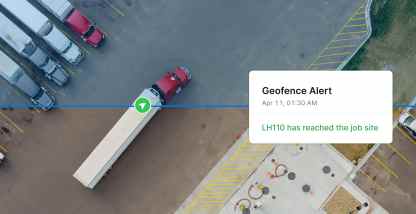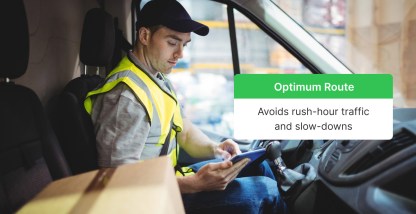If you run a fleet of commercial vehicles and are considering integrating vehicle tracking systems into your operations, then this guide is for you.
What is vehicle GPS tracking?
GPS tracking involves a network of satellites that triangulate a trackable device’s location, movement, and speed. These trackable devices are installed in vehicles or can be held in your hand like a cellphone.
GPS was originally developed for military use. It’s been a standard feature in many car models since the late 1980s. Commercial fleets use GPS tracking systems to maintain accurate information about where their assets are at all times.
Learn more about GPS fleet tracking technology.
Why invest in commercial vehicle tracking
GPS tracking technology helps simplify and improve fleet operations. Instead of having to call drivers to ask for their location, dispatchers can check their online dashboards to view the information in real time.
This helps dispatchers spend less time on the phone. Drivers can focus on the road.
- Plan efficient truck routes
- Streamline employee schedules
- Reduce time spent looking for assets
- Monitor driver behavior and provide incident-specific coaching
- Provide better customer service with accurate and timely information
- Optimize routes to reduce time to destination
- Recover assets after theft
Increase safety and lower costs
GPS tracking systems can help fleets operate more safely. GPS monitors the speeds at which vehicles are traveling. It does it from any remote location by tracking a driver’s rate of acceleration and deceleration or how quickly a driver passes through intersections.
The fleet manager can use that data to reward drivers who drive safely or coach drivers who don’t.
High-performing drivers trigger fewer risky events. That means they’re less likely to be involved in collisions and earn written violations. A GPS tracker can help improve your productivity. It can also help you make informed business decisions.
In knowing where your assets are, you can ensure your trucks spend less time idling.
GPS tracking systems also have geofencing features. Geofencing features can alert you when fleet vehicles leave a predetermined geographic area. Once you set up the virtual borders of your geofence, you can see in real-time when one of your assets enters or leaves the boundary.
The information can increase your fleet’s efficiency. Once you know it’s about to enter your location, you can send an asset back out on a job or to scheduled maintenance.
GPS tracking improves route efficiency
GPS tracking systems help uncover when and where vehicles experience long detention times.
Through geofencing and detention time reporting, Flying Star Transport improved its efficiency by as much as 15%. After implementing GPS tracking on all of its assets, CFO Jayson Boydstun reported that the company’s average of five hours per load dropped to about four hours.
GPS tracking can solve common problems
Problem: Inaccurate Field Information
Fleet managers need to know where their assets are, how long they’re in operation, and where they’re heading. Problem is, information is often sent late. Other times, it’s inaccurate. Especially when drivers are relaying information over the phone.
Solution: GPS truck tracking has a much higher level of accuracy. It tells the exact location of your vehicles and their status. It does it in real time.
Problem: Lack of Accountability
A recent study conducted by Intuit reported that regardless of their clients’ industries, 92% suffer from “time theft.” Time theft happens when employees don’t clock out during unpaid breaks.
Solution: By tracking vehicle location and status, GPS tracking helps hold employees accountable for unsupervised time on the job.
Problem: Lack of Revenue Growth
Without a reliable way of tracking the location and availability of your vehicles, you won’t be able to maximize your fleet’s capacity to generate revenue.
Solution: GPS tracking allows you to view the status of your vehicles remotely. It can show idling vehicles so you can put them to work.
How do vehicle tracking systems support enterprise companies?
GPS fleet tracking has many benefits, such as.
Improved visibility into your operations
By using GPS tracking and telematics, you get access to data that shows whether you’re under- or over-resourced. Data can show how much you’re paying on tolls and violations. If you’re part of a construction company, it can show where your equipment is, and if it’s working or idle. With this information, you can plan better, make decisions more quickly, and reduce cargo theft.
A supply chain risk trend analysis revealed 289 recorded thefts in the first quarter of 2021. Each incident was worth about $142,574.
GPS tracking is a powerful tool to prevent cargo theft. GPS tracks your assets and pinpoints their locations in real time. GPS tracking also helps you identify hot spots for cargo theft in your region and plan routes better.
Fleets can use geofencing to create virtual fences around assets, then receive alerts when an asset crosses that border.
Improved fuel efficiency
Fleets can save money by optimizing fuel use. Since fuel consumption is one of the biggest expenses for a fleet, improving fuel efficiency can significantly impact your company’s bottom line.
Below are tried and tested fuel-saving tips that fleet managers use:
- Integrate fleet management software into operations.
- Conduct route optimization.
- Ensure the tires are properly inflated.
Minimizing poor driving habits
Apart from idling, poor driving habits, such as speeding, hard braking, and hard cornering, can waste fuel. They’re also a potential safety risk.
GPS tracking combined with reliable fleet management software can help you identify poor driving habits.
Reduced driver detention time
Driver detention at receivers and shippers can cost up to $1,280 per driver per year. GPS tracking can play a crucial role in reducing driver detention time and improving overall efficiency.
One example is monitoring the vehicle’s exact location via GPS. You can get a reasonably accurate ETA and let shippers and receivers know location in advance, which may help reduce detention time.
Flying Star Transport increased its efficiency by up to 15% with Motive’s geofencing solution. “We have gone from roughly five hours per load on a 130-mile haul last year, to running about four hours per load on a 120-mile haul this year” says Boydstun.
Improved customer service with geofencing
Great customer service is the key to repeat customers and sustainable growth.
With geofencing and GPS tracking, it’s possible for fleets of all types and sizes to provide timely ETAs and improve the customer experience.
Make data-driven business decisions
Telematics devices and vehicle fleet management software provide valuable data that can help you make informed, data-driven business decisions.
For example, you can identify various routes for your trips and the average amount of time a driver takes to complete each route.
Less downtime and increased productivity
Identifying vehicle issues is key to keeping your expenses in check.
Invest in telematics devices to improve your fleet performance and keep vehicle maintenance issues to a minimum. Telematics devices will help you understand the state of your vehicles by sending real-time alerts when engine problems occur. Staying on top of vehicle health can minimize operational expenses, reduce repair costs, increase time on the road for drivers, and improve productivity.
“I use Motive fault codes daily. Every day, I do an audit of the fault codes. If I see any red flags, as far as brakes or any immediate safety-related concern, I send it to the shop right away,” says Mike Brittingham of EM Way Inc. “[Fault codes] give you a snapshot of when [A component] may be going, and that could be a $14,000 system. If you can replace it for $3,000, then you’re doing OK before it gets down to that full meltdown mode.”
Features to search for in vehicle tracking software
An effective vehicle tracking system should have these features:
- Real-time GPS tracking solution
- Trip history recording
- Driver behavior monitoring
- Scheduling and route optimization
- Vehicle maintenance tracking
Why choose Motive for vehicle tracking services
Motive provides one of the most reliable and sophisticated GPS vehicle tracking solutions on the market. Get real-time visibility into where your vehicles are and where they’re going. You’ll gain access to advanced GPS precision technology to pinpoint specific addresses easily.
GPS features also help ensure your drivers are on schedule. Share estimated arrival times with customers to improve your service delivery and client satisfaction.
Request a free demo today. Eliminate the guesswork and complexities of your vehicle tracking processes for more seamless fleet operations.
Want to read more? View three reasons why fleet managers choose Motive.








